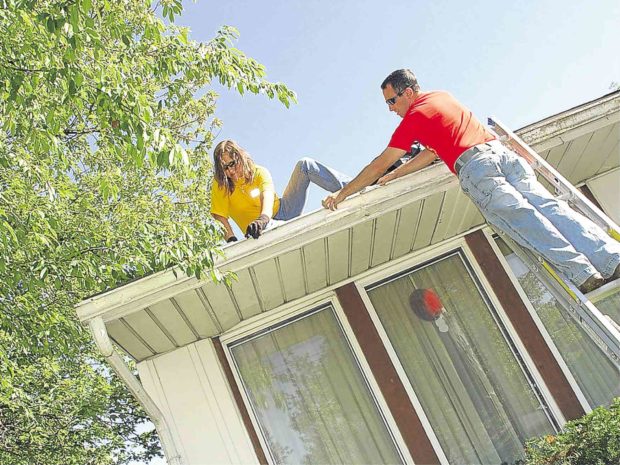Keeping the water at bay
Water can be one man’s blessing, or another man’s curse. Around the world, many people continue to suffer either from a shortage of water or too much of it, due partly to the increasingly adverse effects of climate change.
In the Philippines, when the summer heat becomes unbearable, we often pray for the occasional drizzle. When the rainy season arrives though, many of us pray for the opposite.
As the heavy rains often bring destruction and diseases, Filipinos regard typhoons with wariness and fear. Every year, typhoons wreak havoc on many Filipino homes and properties. Despite early weather forecasts, we can never tell when it is our turn to become the victims.
With the threat of floods accompanying each heavy storm, how can we defend ourselves from too much water? Despite the fact that there is no guaranteed way of preventing floods and rains, how can we prepare our homes to survive these annual occurrences?
Though many flood prevention methods have already been established in our country, it is never a waste of time learning some more. The following points can help us fight against the wet onslaught. Despite heavy rains, maybe these can teach us to love the water.
Strengthen your main door
The entrance door is usually your first line of defense against flood waters. Its material and design often determine whether water can seep through it and cause flooding inside the house. Prior to a typhoon, inspect your existing door and replace it if it is ordinary wood. A door made out of marine plywood, solid wood or PVC works despite the heavy rains. Install a flood protection device to keep water from entering your home.
Increase the slope around your home
Does your house sit on a hill? If it does, consider yourself quite lucky as it is most likely one of the last homes in your area to be reached by water. Don’t fret, however, if it doesn’t. If you don’t have immediate neighbors and don’t mind digging, taking some soil in your yard and adding it around the house perimeter helps deter flood. The slope of the makeshift hill should lead water away from your house.
Clean your gutters
This is easier said than done, but can be worth all the effort. Make it a habit to clean your roof gutters annually to prevent clogging. A well-functioning gutter easily drains out the rainwater away from your home. Without it, water will run down your exterior walls and in time, this may damage the exterior paint or cladding. Hire cleaning services if you cannot do this on your own.
Check your windows
Is water seeping through your window openings? If it does, provide new caulking or install a window seal. The seal can also work wonders on your exterior doors. Fix your windows before the storm hits as caulking requires a bit of lead time to dry. At best, do this during the warm season as it may take up to a couple of days for the caulking to completely dry.
Replace interior finishes
If your home is prone to floods, it is important to prepare its interiors should worse conditions strike. To minimize the damage caused by floods, use materials which are water-resistant and can easily be cleaned if ever they will be exposed to water. Change your baseboard to PVC or install ones that have been coated with varnish. Raise your electrical sockets above the highest flood line to prevent electrical problems. Install ceramic or homogenous tiles over concrete floors to allow easy clean-up and prevent water absorption.
Divert down spouts
Does water drain out right along the edge of your home? This might cause irreversible damage to your foundation if left unaddressed. Buy downspout extenders at the local hardware store and extend your downspout’s length. Author Brett J. West recommends 6-inch black corrugated pipes to do the trick. At best, down spouts should drain in catch basins to prevent water runoff on sidewalks and the streets.
Repair your ceiling
Even before the arrival of rains, check your ceiling for discolored areas and holes. Unrepaired openings will result in leaks inside your house. If you must, replace the affected ceiling panel and paint over the discolored area.
Preparation is the key to ensuring that your home will be able to survive even the worst of rains. Consider these precautions as an investment as it will cost you more to repair damages caused by floods.
Overall, the frequent occurrence of rain is already a fact of life in the Philippines. Rather than fret about typhoons and floods, plan against them so that your home will always be ready for unexpected downpours. You might even take it one step further by installing a rainwater collection system and turning unwanted rainwater into water for the plants.
Now that is a way of turning a catastrophe into a unique opportunity.
(Sources: www.ecomparemo.com; www.washingtonpost.com; www.marydhonau.co.uk; www.installitdirect.com; photo by Oregon Department of Transportation via flickr.com; photo by Scooter133 via Wikimedia Commons; U.S. Navy photo by Chief Mass Communication Specialist Lucy M. Quinn via Wikimedia Commons)
The author is a licensed architect who studied abroad and currently works for DSFN Architects. She loves rainy weather because it’s the best time to sleep but dislikes getting caught in the middle of a flooded street.


